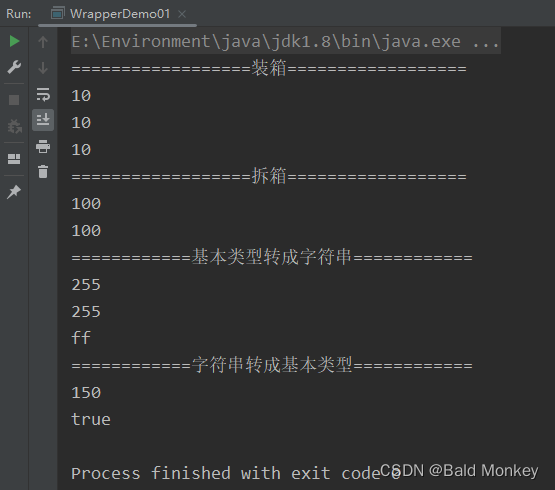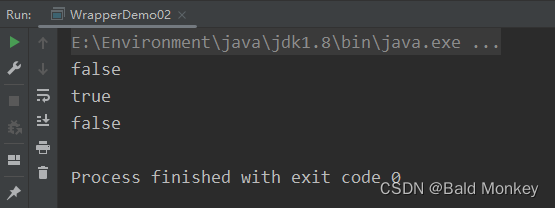Java笔记16
包装类
- Java是面向对象的语言,但并不是“纯面向对象”的,因为我们经常用到的基本数据类型就不是对象。但是我们在实际应用中经常需要将基本数据转化成对象,以便于操作。比如:将基本数据类型存储到Object[]数组或集合中的操作等等。
- 为了解决这个不足,Java在设计类时为每个基本数据类型设计了一个对应的类进行代表,这样八个和基本数据类型对应的类统称为包装类(Wrapper Class)。
- 他们都位于
java.lang包下,对应关系如下表:
| 基本数据类型 | 对应的包装类 |
|---|---|
| byte | Byte |
| short | Short |
| int | Integer |
| long | Long |
| char | Character |
| float | Float |
| double | Double |
| boolean | Boolean |
- 上面8个类,除了
Boolean和Character以外都是数字类型,他们都是抽象类java.lang.Number的子类。而Number类提供了intValue(),longValue等一系列抽象方法,所以几个数字类的包装类都可以相互转型。 - 包装类的基本作用:提供了基本数据类型,包装类,和字符串类型之间的数据转化。
装箱和拆箱

- 手动装箱:
- 方法一:通过
new关键字调用Integer类的构造方法装箱 - 方法二:通过
valueOf()方法装箱(推荐)
- 方法一:通过
- 手动拆箱:
- 使用
xxxValue()方法拆箱,xxx代表基本数据类型,例如:intValue()、doubleValue()等
- 使用
- 在JDK1.5之前,必须手动装箱和拆箱。
- JDK1.5之后,支持自动装箱和拆箱,也就是在进行基本数据类型和对应的包装类转换时,系统将自动进行,这将大大方便程序员的代码书写。
基本数据类型和字符串之间转换
-
基本类型转成字符串:
- 方法一:使用
+号进行转换。Integer类有一个静态的toString()方法,可以将整数转换为字符串。或者直接在整数后面加空字符串即可! - 方法二:使用
Integer类中的toString()方法进行转换
- 方法一:使用
-
字符串转成基本类型:
- 使用
包装类.parseXXX()方法进行转换,XXX代表基本数据类型,例如:Integer.parseInt()、Boolean.parseBoolean()等
- 使用
-
练习:
package com.clown.classes.others;
public class WrapperDemo01 {
public static void main(String[] args) {
System.out.println("==================装箱==================");
//类型转换:装箱,基本数据类型转换为包装类(引用类型)
int num = 10;
//自动装箱: JDK1.5之后的特性,使用了valueOf()方法 Integer.valueOf(num)
Integer integer = num;
//手动装箱:
Integer integer1 = new Integer(num); //方法一:通过 new关键字调用构造方法装箱
Integer integer2 = Integer.valueOf(num); //方法二:通过valueOf()方法装箱 推荐!!!
System.out.println(integer+"\n"+integer1+"\n"+integer2);
System.out.println("==================拆箱==================");
//类型转换:拆箱,包装类(引用类型)转换为基本数据类型
Integer integer3 = Integer.valueOf(100);
//自动拆箱: JDK1.5之后的特性
int a = integer3;
//手动拆箱:
int b = integer3.intValue();
System.out.println(a+"\n"+b);
System.out.println("============基本类型转成字符串============");
int n1 = 255;
//1.使用 +号
String s1 = n1 + "";
//2.使用 Integer中的 toString()方法
String s2 = Integer.toString(n1);
String s3 = Integer.toString(n1,16); //toString(int i, int radix)是toString()方法的一个重载方法,其中参数 int radix表示进制
System.out.println(s1+"\n"+s2+"\n"+s3);
System.out.println("============字符串转成基本类型============");
String str1 = "150"; //注意保证类型兼容,否则抛出 NumberFormatException异常!
String str2 = "true";
//使用 包装类.parseXXX()方法 XXX代表基本数据类型~
int n2 = Integer.parseInt(str1);
boolean n3 = Boolean.parseBoolean(str2); //仅当输入字符串为 "true"时,输出 true,输入为其他非 "true"的字符串时,结果都为 false
System.out.println(n2);
System.out.println(n3);
}
}
运行结果:

整数缓冲区
- Java预先创建了256个常用的整数包装类型对象。
- 在实际应用当中,对已创建的对象进行复用。
package com.clown.classes.others;
//整数缓冲区
public class WrapperDemo02 {
public static void main(String[] args) {
//1.
Integer integer1 = new Integer(100);
Integer integer2 = new Integer(100);
System.out.println(integer1 == integer2); //false
/*
基本数据类型中, == 比较的是数值。
引用数据类型中, == 和 默认的 equals()方法比较的是地址值
*/
//2.
Integer integer3 = Integer.valueOf(100); //自动装箱也是使用的 Integer.valueOf()方法
Integer integer4 = Integer.valueOf(100);
System.out.println(integer3 == integer4); //true
//3.
Integer integer5 = Integer.valueOf(200);
Integer integer6 = Integer.valueOf(200);
System.out.println(integer5 == integer6); //false
}
}
先看运行结果:

发现:代码块1的运行结果为false、代码块2的运行结果为true、代码块3的运行结果为false
- 探究原因:
代码块1的装箱过程可用下图表示:

可以看出对象integer1和对象integer2的地址不同,故输出false。
查看valueOf()方法在Integer类中的源代码:
private static class IntegerCache {
static final int low = -128;
static final int high;
static final Integer cache[];
static {
// high value may be configured by property
int h = 127;
String integerCacheHighPropValue =
sun.misc.VM.getSavedProperty("java.lang.Integer.IntegerCache.high");
if (integerCacheHighPropValue != null) {
try {
int i = parseInt(integerCacheHighPropValue);
i = Math.max(i, 127);
// Maximum array size is Integer.MAX_VALUE
h = Math.min(i, Integer.MAX_VALUE - (-low) -1);
} catch( NumberFormatException nfe) {
// If the property cannot be parsed into an int, ignore it.
}
}
high = h;
cache = new Integer[(high - low) + 1];
int j = low;
for(int k = 0; k < cache.length; k++)
cache[k] = new Integer(j++);
// range [-128, 127] must be interned (JLS7 5.1.7)
assert IntegerCache.high >= 127;
}
private IntegerCache() {}
}
public static Integer valueOf(int i) {
if (i >= IntegerCache.low && i <= IntegerCache.high)
return IntegerCache.cache[i + (-IntegerCache.low)];
return new Integer(i);
}
可以发现valueOf()方法实际上创建了一个IntegerCache(整数缓冲区),并将区间为[-128, 127]的整数都实例化保存在里面。当我们使用valueOf()方法进行装箱时,如果我们准备装箱的整数在区间[-128, 127]内,则直接复用缓冲区内已经实例化好的对象,如果准备装箱的整数不在区间[-128, 127]内,则使用new关键字实例化对象。
所以,代码块2和代码块3可以这样理解:
代码块2:

可以看出对象integer3和对象integer4的地址相同,故输出true。
代码块3:

可以看出对象integer5和对象integer6的地址不同,故输出false。






















 1908
1908











 被折叠的 条评论
为什么被折叠?
被折叠的 条评论
为什么被折叠?








